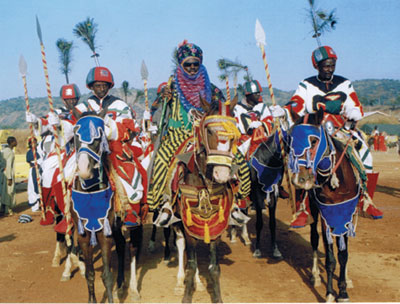
Don't forget to mark your calendar!!! Saminaka will host SL's first-ever African Festival, and we want to make it a memorable one! In addition to some new architecture, there will be lectures, contests, a decorated canoe regatta (see last week's issue), parties with African music, demonstrations, masqueraders, stiltwalkers and acrobats, a treasure hunt, several exhibitions, readings, and...a durbar!
What? You didn't all react with astonishment and joy? Did I sense some of you scratching your heads and mouthing, "What's a durbar?" What indeed? The durbar is one of those rare b
 reeds--something introduced by colonialists that everybody enjoys! The British took the concept of Indian displays of horsemanship, the product of Mogul courts, whispered about it to the Hausa emirs, and presto! A new form of royal entertainment was born.
reeds--something introduced by colonialists that everybody enjoys! The British took the concept of Indian displays of horsemanship, the product of Mogul courts, whispered about it to the Hausa emirs, and presto! A new form of royal entertainment was born."Durbar" is actually a Persian word, used to mean either a state council meeting in India or, under the British, a ceremonial review. The first was a demonstration of loyalty to the Crown held in 1877 when Victoria was first called "Empress of India," but they were regular features of the British Raj.
While the purpose in Nigeria may have been similar in colonial days, durbars persist in numerous Northern Nigerian emirates, a way for rulers to dazzle their constituents and bask in the approval and admiration of their citizens. These celebrations consist of a parade on horseback by the king, his chiefs, and selected officials, accompanied by music. They are a considerable draw for tourists as well as the

community, and are scheduled during sallah (religious celebration) periods, primarily at Eid-el-Fitr and Eid-el-Kabir.
While durbars are mostly Hausa festivals (held regularly at Kano, Zaria, Bauchi, and Katsina), the Nupe also hold them at Bida. They are most definitely events at which one sees and is seen, and they evoke the historical past when savannah armies on horseback crossed large territories, officers in splendid embroidered robes and turbans. The horses themselves are on show as well, wearing leather and metallic trappings like the finest of jewels.
Saminaka's durbar may include some citizens on horseback, but it will certainly include horse avatars enjoying the admiration of onlookers. In the week or so prior to the festival, Northern Nigerian leatherworkers will enter the sim to put their products in the market for the interested equine community. The festival itself will include a colorful slide display and examination of the horse's place in African history, as well as a book that includes the identical information. Come saddle up with us!





No comments:
Post a Comment